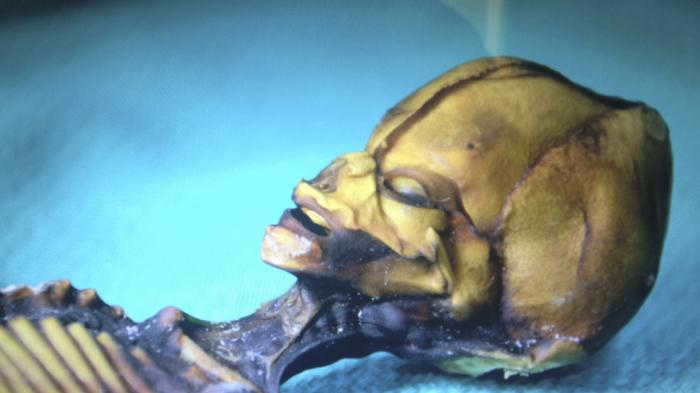Throughout history, there have always been skeptics who doubted the idea that planets and stars could have a significant impact on human destinies. Thinkers like Cicero, Plotinus, and Favorinus of Arelate held this belief. However, delving into this topic reveals that the small, bright points in the night sky have captivated the human imagination and influenced our actions for centuries. The enigmatic star Sirius is a perfect illustration that the power of the stars should never be underestimated when it comes to shaping the fate of humanity.
There are numerous undeniable astronomical factors that make Sirius an extraordinary celestial object; they are widely recognized. It is the most brilliant star in the sky (1.47m), one of the nearest to us (or rather, the seventh nearest, with a distance to the Sun of 2.6 parsecs, and it continues to approach). Sirius, specifically, was the initial star to be observed moving across the sky, and it was the first whose rate of movement could be determined by scientists. Further investigation has confirmed that Sirius is a binary star, comprising of a star of spectral class A1 and a white dwarf (by the way, the first white dwarf ever discovered), revolving around the center of mass with a period of approximately 50 years. There are suspicions that another star rotates nearby and a third “brother”, but they have not yet received scientific confirmation. So for astronomers, there is no doubt about the significance of the “luminous” or “dog” star for us. But is it only important for astronomers? And the immense significance of Sirius for navigation, as well, can hardly fully account for the incredible importance that ancient people attributed to Sirius.
You are welcome to establish your personal astrological workspace where you can explore all the details about yourself and your future predictions!
Here are the available calculations:
- Get a free version of your Horoscope
- Birth horoscope accommodation
- Micro-horoscopes – 210 answers to your most personal questions
- Compatibility analysis based on 12 unique categories
- Today’s horoscope, forecast for 2023, and various types of predictions
- Cosmogram, karmic, and business horoscope
- Event chart – horoscopes for others, selection of favorable days, and events
Stepping a little aside, I would like to mention that based on one theory, the name “Sirius” is linked to the god Osiris, suggesting the possibility of a shared astrological influence that connects Sirius with the planets in our solar system. Moreover, in mystical teachings, Sirius was referred to as “the sun behind the sun.” This implies that the ancients regarded this star as part of their celestial “family.”
Interestingly, Sirius is visible from nearly all inhabited regions on Earth, allowing ancient civilizations to “communicate” with the star and actively engage with it! In optimal conditions and with a clear sky, the star can even be observed during daylight hours with the unaided eye.
The galactic canine racing across the planet
Modern man knows that Sirius, the alpha star of the Big Dog constellation, is commonly referred to as the “Dog Star.” However, the ancient people who lived in different parts of the world, without the all-pervasive Internet, had their own associations with this star, which remains a mystery to this day. Chinese and Japanese astronomers called it the “star of the celestial wolf,” while Indian tribes believed it had a close connection to dogs. The Blackfoot tribe called it “Dog Face,” southwestern tribes referred to it as “the dog that follows the mountain sheep,” and the Cherokees believed Sirius and Antares were dog-like watchmen guarding the “Path of Souls.” Other Indian names for the star included “Wolf Star” and “Coyote Star.” In Russia, it was known as “psitsa,” and the Bering Strait people called it “Moon Dog.” In ancient Chaldea, it was known as the “Dog Star that points the way,” and in Assyria, it was nicknamed the “Sun Dog.” According to one Indian legend, Sirius is the embodiment of the faithful dog Svana, who followed Prince Yudhisthira in search of the gateway to the heavenly abode. With such a unanimous belief in these associations, it is not difficult to understand the astrological assertion that the heavenly bodies themselves “reveal” their names.
Speaking of which, it is worth noting another fascinating astronomical enigma: the hue of the celestial body. According to various historical accounts, beginning with the writings of astronomer Claudius Ptolemy, Sirius was classified as a red star, a classification that persisted until the second century B.C. when it was recognized as white. There are even references to its color being described as “sea blue”. In China, Sirius was revered as the epitome of pure white. Naturally, stars do undergo changes in color, although these transformations typically occur over significantly longer periods of time.
Origin of ancient beliefs
Was the extraordinary brightness and visibility of Sirius the sole reason why ancient civilizations felt a profound and enigmatic connection to this celestial body? Sirius was viewed as the “sun behind the sun,” the ultimate and original source of light and energy. While our sun sustained physical existence, Sirius was believed to sustain spiritual existence. Consequently, this star was seen as the messenger of all things divine on Earth. Many believed that great Teachers originated from Sirius, and the phrase “blue blood” is associated with the notion that the spiritual aristocracy came from a distant, blue world unlike our own.
According to occultists, the construction of the great pyramid of Giza was meticulously aligned with the positions of celestial bodies such as Sirius and other significant stars, which played a crucial role in the conduct of ancient mysteries. It was believed that at a specific moment, the light of the “shining star” would shine upon the “Stone of Deity” located at the upper end of the Great Gallery, illuminating the forehead of the Great Priest. This divine light would transmit solar power to the priest, awakening his Solar Body and enabling him to perform the initiation ceremony for novices. The symbol of the star above the pyramid is depicted in numerous mystical artworks.
The Egyptian calendar was governed by Sirius, with its heliacal rising marking the start of the year. The priests relied on its appearance to accurately predict the onset of the Nile flood. Until Sirius made its appearance in the sky, the Egyptians refrained from burying the deceased. Sirius was believed to be the gateway to the afterlife, and with the “door closed,” the souls of the departed were unable to reach heaven. Interestingly, Chinese beliefs also place this celestial region as the bridge connecting heaven and the underworld, where the judge resides to pass judgment on the culmination of a person’s life.
Embarking on the cosmic bridge: A journey to Earth
There is a concept that many ancient tribes, well before the invention of telescopes, possessed remarkably accurate knowledge about the planets and stars. For instance, in the 1930s, an astounding revelation came to light: the Dogon, a tribe residing in eastern Mali, possessed knowledge that Sirius was, in fact, a binary star system, with the second star being smaller and exceptionally dense, and even knew its rotational period. On the day when Sirius B completes a full revolution, the Dogon would hold a celebratory feast as it marked the reception of significant celestial information, which the priests would then interpret and pass on to their fellow tribesmen. According to their beliefs, humans descended from the Nommo, an amphibious race that inhabited one of the star planets and arrived on earth via a spacecraft that emitted “fire and thunder.” They shared with the Dogon a multitude of insights regarding cosmic entities, with a particular focus on their own solar system.
As stated, after sharing knowledge that was previously unreachable to mankind, Hermes once again “ascended to the stars”. According to some bold hypotheses, the Earth’s fundamental mystery, or the nommo ship, if you prefer, may still be present in the solar system, disguised as a satellite.
Master of Wisdom
The teachings of Hermes, rooted in ancient mythologies, have served as the foundation for various occult schools and orders that continue to exist today, such as the Frankmasons, Golden Dawn, and Rose and Cross. Within occult circles, Sirius is revered and associated with numerous honorable attributes, including being hailed as the “God of Time,” the “creator of the seasons,” the “inexhaustible source of life,” the “universal seed of all things,” the “spark of uncreated fire,” and, most notably, the “Lord of Knowledge.” As a symbol of the Divine, Sirius embodies the qualities of omniscience and omnipresence, which are frequently depicted in visual arts, notably the Tarot card “Star.” According to occult sources, the attainment of perfection involves a profound comprehension and internalization of the concept of duality, reminiscent of Sirius being a binary star system. This concept is symbolized by the union of Osiris and Isis, resulting in the birth of Horus, the star child, whose emblem is represented by Sirius. The “all-seeing eye of Horus” is often depicted with a radiant light emanating from a celestial star. The eye itself is typically enclosed within a triangle or a five-pointed star. Thus, it is the “celestial dog” that can be observed on the dollar bill.
Elena Roerich, in her Cosmological Notes, suggests that our Sun is not the only star that has an influence on our solar system. According to her, Sirius, which she refers to as the younger brother of our Sun, has a powerful system of spatial bodies, including several sun-planets that are located at great distances from it.
In addition to the physical aspects of the cosmos, Roerich also believes that spiritual growth is connected to celestial bodies. In her “Diaries,” she writes about the importance of the star Alagabad in this process. She states that hymns should be sung to the Mother of the World, and the appearance of the Three Beginnings will be initiated by the songs dedicated to Alagabad. She encourages the readers to embrace the rays of Alagabad and to connect with the divine energy represented by this star.
By now, you may have already guessed that the star referred to as “Alagabad” is Sirius.
Sirius in the 20th Century
Is it possible to consider all of this information as exclusively belonging to the “obscure” past and having no impact on the life of the modern individual?
In various forms, Sirius continues to be present in modern culture, albeit in a less obvious manner. The well-known tale of Pinocchio, which depicts the process of initiation or the transformation of a “subhuman” into a human boy, is guided by a fairy who possesses azure hair of clearly otherworldly origin. Additionally, the famous song “When You Wish upon a Star,” written by Lee Harline and Ned Washington, featured in the 1940 animated adaptation of Pinocchio, is actually about Sirius.
Fans of J.K. Rowling will immediately be reminded of Sirius Black, a direct allusion to Sirius B, the darker star in the system, which explains his ability to transform into a dog. Many aspects of Rowling’s portrayal of this character are “inspired” by the mythological history of the most renowned star in the celestial sphere.
However, these are the products of imagination, while the event that occurred in the United States in 1993 is a testament to harsh reality. In June of that year, the largest flood in the history of Mississippi took place. When the Sun concealed Sirius from Earth, the river overflowed its banks. As Sirius emerged from behind the Sun in mid-August, the water began to recede. During this time, both stars A and B were at their closest proximity to each other.
An auspicious symbol on your astrological chart
Is it just a random occurrence? Perhaps, if you don’t believe in astrology. However, it is beneficial for us to consider the impact of Sirius on our lives. Ancient astrologers attributed to Sirius the qualities of Jupiter (associated with religion and spiritual teachers) and Mars (possibly linked to the star’s red color, mentioned by Ptolemy). Consequently, Sirius brings honor, fame, and prosperity from Jupiter, as well as leadership abilities to your birth chart. However, it also brings passion, irritability, and the potential for danger from impulsive actions, fire, and drought from Mars. When Sirius reaches its zenith in your chart, it signifies high status, a good reputation, and a stable income. In an “unfortunate” configuration, Sirius can indicate a threat from dogs and wolves. Its specific position in the horoscope is at 14 degrees of Cancer, with a 2-degree allowance for major aspects.
When the Sun is present, it signifies success in business and self-expression, as well as opportunities for a brilliant career. This profession may be associated with metals and military affairs.
When the Moon is present, it indicates a favorable environment both at home and at work. One of the parents may have a successful career, and there may be patrons of the opposite sex. Additionally, good health can be expected.
With the presence of Mercury, success in business is likely, along with the support of influential individuals. Obtaining information will be easy, although unnecessary worries and travel may arise. There may also be connections with the church, as well as an interest in religion and the occult.
When Venus is present, it suggests a preference for comfort and convenience, as well as a tendency towards wastefulness. There may also be an inheritance received.
Mars signifies bravery, generosity, and success in military professions.
With the presence of Jupiter, career success is indicated, particularly in professions related to religion and traveling. Help from relatives can also be expected.
When Saturn is present in a horoscope, it signifies loyalty, restraint, diplomacy, and the attainment of a high position through friends. It also indicates family prosperity and the likelihood of receiving an inheritance.
Having Uranus in a horoscope suggests fame and usefulness in non-governmental organizations, as well as help from friends. Additionally, it indicates that things may improve after marriage, especially in the male horoscope.
If Neptune is found in a horoscope, it signifies developed intuition, an interest in occultism, piety, organizational skills, success in commerce, and harmony within the family.
When Pluto is present in a horoscope, it suggests support from influential people, a favorable marriage, the possibility of receiving an inheritance, but also a potential exposure to danger due to arrogance.
Can we confidently assert that Sirius is merely a convenient symbol for ancient myths, or even modern ones? Is the centuries-long worship of this bright star solely the result of unbridled imagination? Or do the twinkling celestial bodies in the sky guide our souls along an invisible, yet significant, path?
Keywords: Sirius, star, Big Dog, constellation, astronomy, cosmos, calendar, heliacal rising, spiritual beginning, astrologers, antiquity
December 2012 Prediction
December 2012 – Astrological prediction: planetary aspects and transits for today, week, month, year – Professional Association
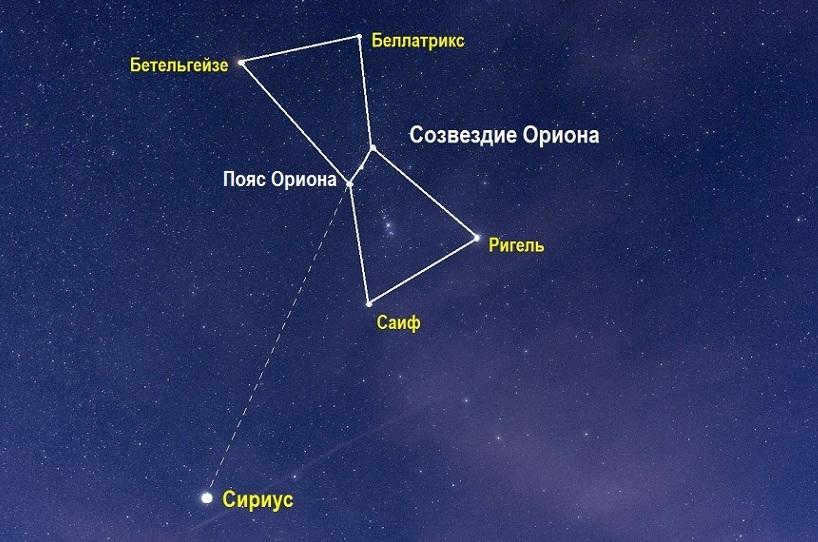
The most prominent celestial body in the nighttime sky in both the Northern and Southern Hemispheres is Sirius, which is situated in the Big Dog constellation. While this constellation is primarily visible in the southern skies, Sirius can also be observed in Russia from late autumn to spring. It is particularly noticeable during the winter months when it reaches its highest point above the horizon. To locate Sirius, one can refer to the well-known constellation Orion, with Sirius positioned in the southern region of the night sky, below and to the east (left) of the Hunter of the Skies. The line connecting the three largest stars in Orion’s Belt indicates the general direction of Sirius (refer to the accompanying image). Although not perfectly accurate, the brightness of Sirius, also known as the alpha star of the Big Dog, makes it nearly impossible to misidentify.
In this article, we will discuss the most well-known astronyms that have been used as proper names for Sirius.
Astronyms
Throughout history, various names have been given to this star. The ancient Sumerians, for instance, referred to it as the Arrow, while the Chinese called it the Wolf.
Many cultures have named this star based on its association with the constellation of the Big Dog. This tradition originated with the Greeks, who knew Sirius as the Dog (Κύων). The ancient Romans used a diminutive form, referring to it as Doggie (in Latin, Canicula). The Arab scientists also contributed their own name, with Omar Khayyam calling Sirius the Dog of the Giant (referring to the constellation Orion as the Giant).
“Dog” names of Sirius in various languages have persisted into the present day. For instance, in Russian texts from the 16th century, it was referred to as Psitsa, Kanikula, Pesya zvezda. Some of these variations were still used in the 18th century alongside the contemporary term. In modern English, the brightest star in the night sky is commonly known as Sirius, but it is also referred to as the Dog-star.
Interestingly, the Latin name for Sirius is derived from the word vacation ‘a period of rest for students; a recess in parliament’. What is the connection?
The reason is that in ancient times in the Mediterranean, the rising of Sirius in the mornings just before the Sun coincided with the start of the hottest time of the year. The Greeks used to refer to this period as ‘ἐπὶ κυνί’ (‘epi cyni’), which means ‘on the hot days when Sirius rises’ (literally: ‘at the dog, during the dog’). This season began in mid-July. This is how the ancient Greek poet Alcaeus (late 7th – early 6th century BC) described it in his poem ‘Summer’:
My throat is parched, my friends, –
Give me wine!
The starry Hound is raging.
The scorching heat of summer is intense and overwhelming, causing the earth to become parched and burning.
Instead of the usual sound of cicadas, there is a different type of singer in this heatwave. The cicada’s song is a constant reminder of this blistering heat.
The sound of the cicada’s wings is like a tinkling melody that fills the air, echoing through the branches of trees.
In the meadows, the once vibrant colors have now withered and faded due to the intense heat.
It feels like everything is coming to an end. The dogs are going crazy, along with the women, and even the husband is exhausted, dried up and burnt out by this relentless heat.
(Translated by Vyacheslav Ivanov)
Influenced by Greek culture, the ancient Romans came up with the phrase “diēs canīculāres” to describe the peak of summer heat. diēs canīculāres means ‘hot (literally: doggy) days’ in Latin, referring to the Dog Star – Canicula. This saying was later translated into other languages. In French, for instance, there is the expression jours caniculaires meaning “the hottest days of summer”, while in English, we have the term dog-days. In German, it is called Hundstage with the same meaning. All of these are borrowed from Latin expressions. And what about in the Russian language?
In the third volume of the “Dictionary of the Academy of Russian” in 1792, the word “vacations” borrowed from Latin and a partial tracing of the Latin phrase “diēs canīculāres” – “vacation days” were recorded. The meaning is ‘the period from July 12 to August 12, when there is intense heat’. Here is an example of usage:
In times of extreme heat, particularly during vacations, instead of consuming bullion or whey, it is advisable to drink a refreshing glass of water in the morning, perhaps mixed with something that might not be to the liking of hypochondriacs; it would be akin to a julep or a sweet beverage.
(Francisco Redi. On Hypochondriacal Disease // Monthly Works for Benefit and Amusement. 1755 г.)
During the first half of the 19th century, the term vacations took on its current definition of “a pause in academic pursuits.” This evolution is logical, as many tasks and activities are put on hold during the hottest part of the day.
Other languages do not have similar connotations for related words. Previously, we provided examples where loanwords and derivatives from Latin canicula/dies caniculares referred to the peak of summer heat. The concept of “vacation, recess” in these languages is conveyed by different terms:
The term vacation in the sense of “break in studies, time of rest” is now only found in East Slavic languages. In Polish as well, the word kanikuła used to have the same meaning. However, this semantic association is now outdated in the Polish language.
Let’s now return to the ancient Greeks. They referred to the brightest star as not just Dog, but also as Sirius proper (Σείριος). What is the origin of this name?
“Greek” version
In the field of science, it is widely believed that this astral name has its roots in Greek and is derived from the adjective σείριος (sirios) meaning ‘scorching, burning, sultry’. The Greeks held the belief that Sirius was responsible for the intensification of summer heat, and that the air became hot due to the star’s radiant glow.
“Arab” version
However, there exists an alternative theory. According to this hypothesis, the Greek language actually borrowed the name Sirius from Arabic. In Arabic, the star is referred to as ash-Shi’ra, which means “the one who opens the door.” This name could have been given to the star because its appearance above the horizon symbolized the start of a new year or season. The Greeks later interpreted the name differently, associating it with a more understandable adjective.
So, which version is correct? On one hand, there are numerous star names of Arabic origin in the night sky map. On the other hand, the etymology of the name Sirius as an original Greek term seems more plausible. Its meaning, “scorching” or “burning,” is convincingly linked to a prominent natural phenomenon – the onset of the peak of summer heat.
Due to the complex movement of celestial objects, the apparent position of stars in the sky undergoes changes over the course of centuries. Several thousand years ago, Sirius could be seen above the horizon at different times and at different latitudes. Nowadays, we can admire the alpha of the Big Dog in Russia on a chilly winter night, while also envisioning it in the rays of the rising sun during the midst of summer in ancient Greece…
Karpenko Yu. Names of the starry sky. – Moscow, 1981.
Chernykh P. Ya. Historico-etymological dictionary of the modern Russian language. – Vol. 1. – Moscow, 1999.
Zhuravlev A. F. Language and myth. – Moscow, 2005.
Kurtik G. E. Starry sky of ancient Mesopotamia. – St. Petersburg, 2007.
Shcheglov P. V. Reflected in the Sky Myths of the Earth. – Moscow, 1996.
Dictionary of the Russian language from the 11th to the 17th centuries. – Issue 21. – Moscow, 1995.
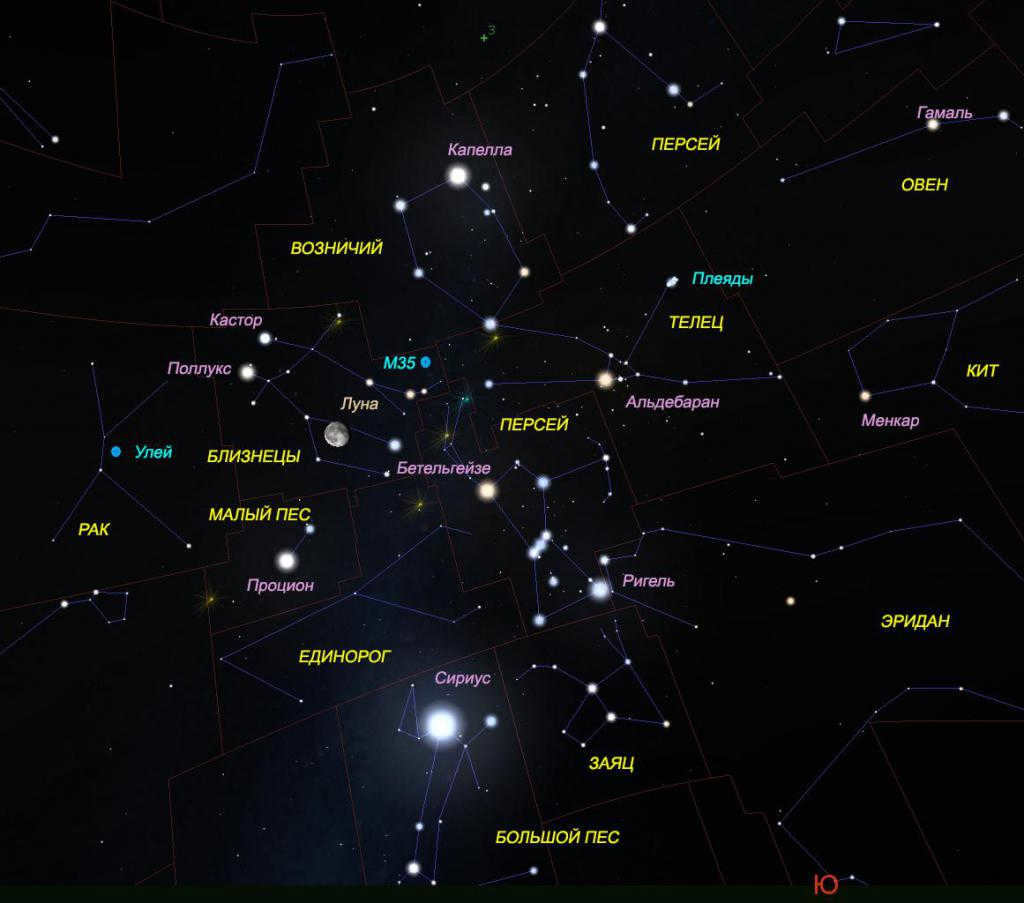
Sirius – the most shining star
The title of this star is related to the Greek word Σειριοζ, which signifies “splendid”. Furthermore, this is not astonishing, in light of the fact that even old space experts saw its brilliant light. Indeed, even today, Sirius, a star in the group of stars of the Big Dog, is the most splendid item after the Sun, Moon, and three planets (Venus, Jupiter, Mars) in resistance years. It is basically difficult to mistake this heavenly body for others.

Sirius in the ancient civilizations
The study of the stars, known as astronomy, was initially a practical field of science. Navigators and travelers relied on the stars to find their way, and calendars were created based on astronomical observations. It’s no wonder that our ancestors were fascinated by the brightness of Sirius.
In ancient Egypt, Sirius was known as Sotis and was associated with the goddess of agriculture, Isis. The heliacal rising of Sirius, which marked its first appearance in the morning dawn, coincided with the beginning of the flooding of the Nile River. This annual event brought fertile silt to the valleys and signaled the start of the agricultural season.
Centuries ago, Sirius was connected to the periods of universal relaxation, or more commonly known as vacations (dies caniculares – “dog days”). This celestial body leads the way in the Big Dog constellation, which the ancient Greeks and Romans linked to the deity Orion and the neighboring constellation with the same name. They even perceived them as interconnected and referred to Sirius as “Orion the Hunter Dog”. The heliacal rising of Alpha in the Big Dog constellation aligned with the beginning of the warmest season of the year (late June – early July), and people in this area preferred to enjoy the heat while taking a break.
Chinese stargazers gave this celestial body the name Lan (Wolf) or Tianlan (Heavenly Wolf). The initial enigma surrounding Sirius is linked to the accounts of early astronomers, who described its color differently. According to ancient texts, the star emitted a red light, yet we perceive it as a bluish-white hue. However, we will delve into this matter further in due course.
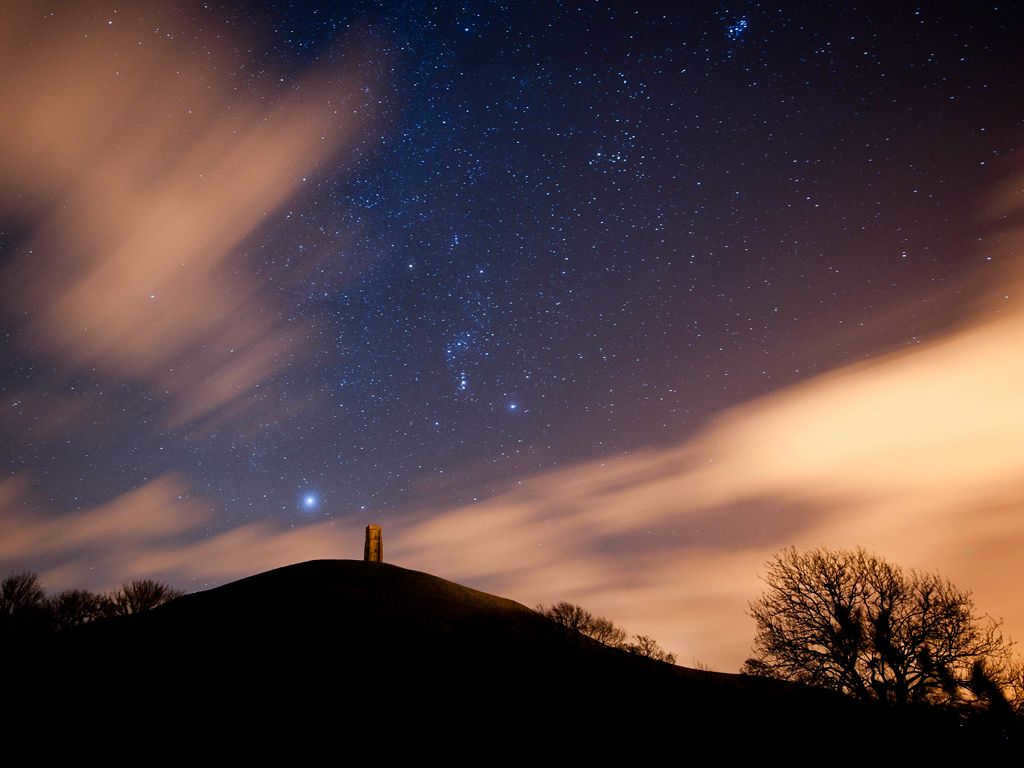
Sirius and the Vastness of Space
As recorded in history, ancient astronomy was largely forgotten for many centuries. It wasn’t until Nicholas Copernicus (1473-1543) introduced his theory of the heliocentric structure of the solar system that astronomy began to regain momentum in its development. Alongside the understanding of planet motion around the Sun came the realization that all celestial bodies also follow specific orbits. However, even with the advent of early telescopes, no changes in the position of stars (parallax) could be detected.
Johann Lambert (1728-1777) made the second effort to establish cosmic distances. Once again, the focal point was Sirius, and this particular astronomer calculated its distance as 8 light-years. Interestingly, contemporary astronomy now estimates the distance to Alpha Canis Majoris, also known as the Big Dog, to be 8.6 light-years.

Sirius and its significance
Therefore, we have the introduction of Edmund Halley (1656-1742), who is famously associated with the comet that bears his name. In 1718, he made a remarkable discovery regarding the shifting positions of stars over a span of two millennia. Halley conducted a comparative analysis of the ancient atlases created by Ptolemy, Hipparchus, and Timoharis, with the modern astronomical data. As a result, he arrived at a clear conclusion regarding the movement of stars in the vast expanse of outer space.
Thanks to the application of Newtonian mechanics to astronomy, it became possible to calculate the precise position of celestial bodies and make predictions about their behavior. It was through this scientific framework that the existence of an invisible companion to the star Sirius was first hypothesized and later confirmed. The astronomer and mathematician Friedrich Wilhelm Bessel, who served as the director of the Königsberg Observatory, made this groundbreaking discovery. It was not until 1862 that Alvan Clarke, using a 46-centimeter lens telescope, was able to visually observe this satellite, which came to be known as the “dark star Bessel.” This remarkable finding marked the identification of Sirius B, the first white dwarf ever discovered, characterized by its incredibly high density of 60 kg/cm 3.
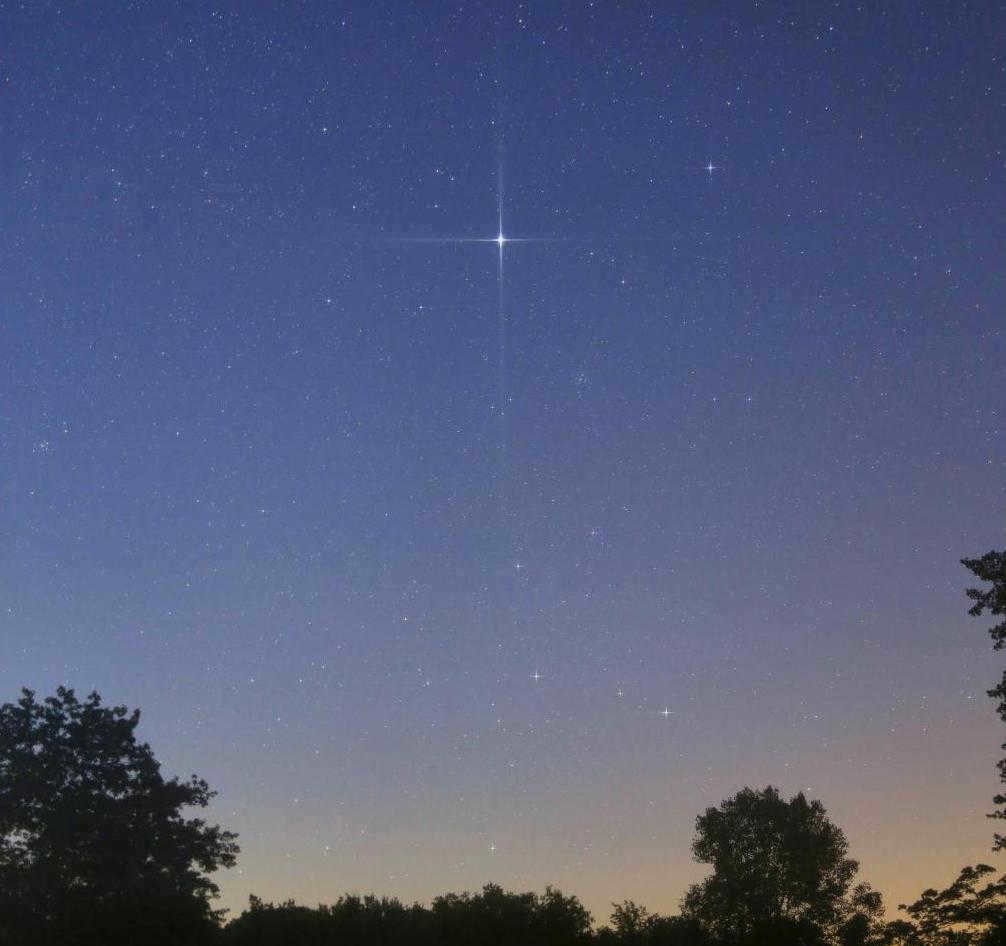
Latest information
Sirius forms part of the star cluster known as the “winter triangle” along with the stars Alpha Orion (Betelgeuse) and Alpha Minor Dog (Procyon). The angular separation between Sirius and Polaris is 106 degrees. Presently, it is widely accepted that the distance between Earth and Sirius is 8.58 light-years, which makes it the fifth farthest star from our Sun. In terms of size, Sirius is 1.71 times larger than our Sun and has a mass 2.02 times greater. This scorching white star has a temperature of 10,500 degrees Kelvin and a luminosity of 1.47 m, making it the most brilliant star in the Canis Major constellation. Additionally, Sirius is moving towards our solar system at a speed of 7.6 km/sec.

A star system with multiple stars
Today, we are aware that Sirius is a binary star system consisting of Sirius Alpha (A1 star) and Sirius Beta (white dwarf). The distance between these two stars is similar to the distance between the Sun and Uranus, and they orbit around their common center of mass with a 50-year period. This star system is approximately 250 million years old and has completed only one revolution around the center of our galaxy, whereas the Sun has already completed 20 such revolutions. However, Sirius has already spent half of its lifetime in the Milky Way. In approximately 300 million years, Sirius will deplete its internal resources and undergo a transformation into a red giant, eventually becoming a white dwarf known as Sirius B. These white dwarfs are essentially the remnants of former massive stars, now cooled down. According to scientists, Sirius B was once a bright white star with a mass five times greater than that of the Sun and emitted much more light than the current Sirius A.
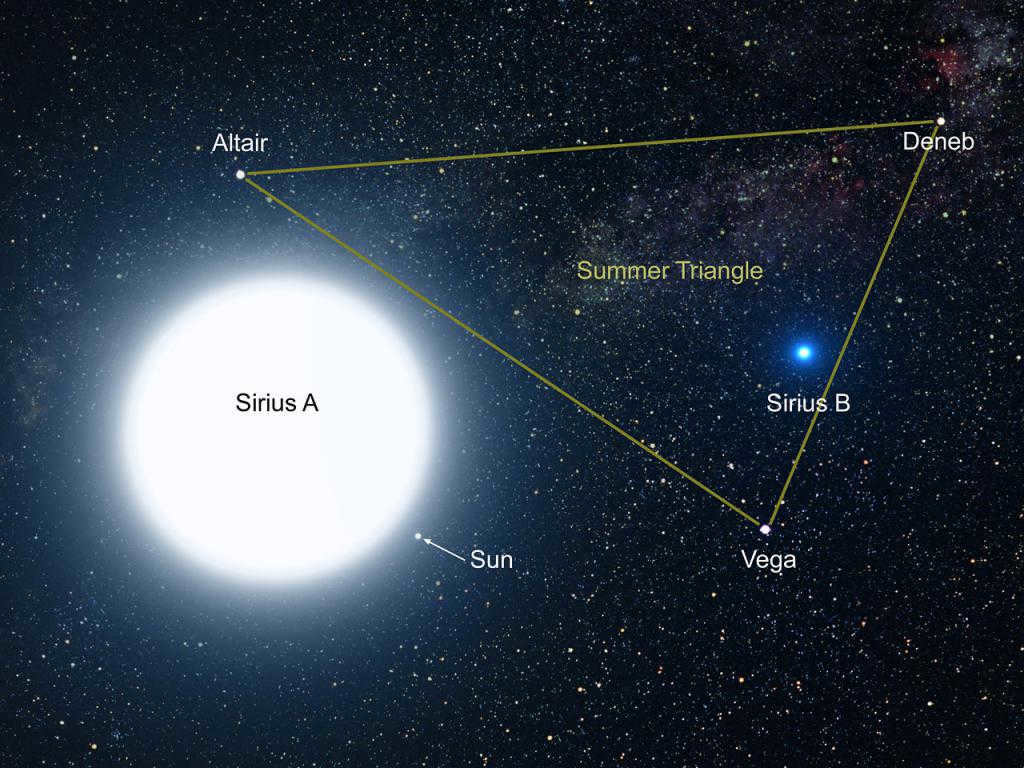
The initial enigma of Sirius has nearly been unraveled
The primary puzzle lies in the alteration of the star’s spectral luminescence. Ancient astronomers depicted Sirius as a star with a red spectrum. In the writings of Seneca (1st century AD) and Ptolemy (2nd century AD), it appears to possess a deeper red hue than the distinctly red planet Mars.
The transformation of stars from red giants to white dwarfs is a common occurrence in modern astronomy. However, this evolution typically spans millions of years and leaves behind remnants in the form of dust and gas clouds surrounding the star. In the case of Sirius, its color shift occurred over a mere 2,000 years.
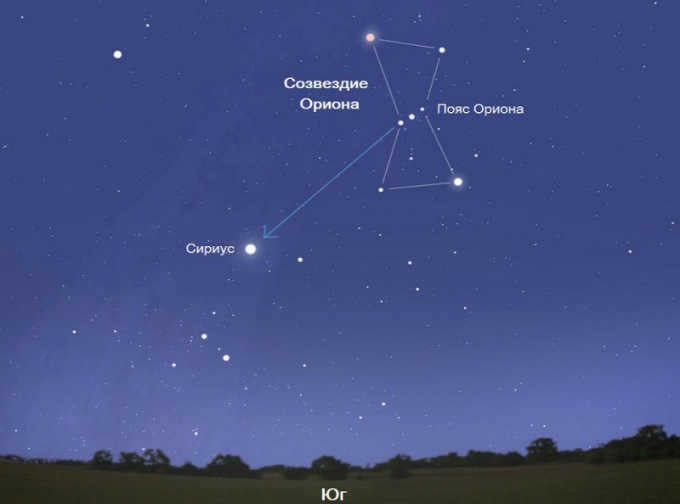
The role of humans
There are several explanations for this transformation:
- One possible explanation is that there were translation errors or metaphorical descriptions. In ancient times, the color red was often associated with negative events, so it is possible that Sirius, when it rose on the morning horizon, was metaphorically described in ominous tones. For example, in ancient Rome, the Robigalia festivals were held to honor the goddess Robigo, who protected grain crops. The main sacrifice during these festivals was a red dog.
Scientific hypotheses
Scientists propose alternative explanations for this phenomenon:
- The hypothesis that the red giant Sirius B died and transformed into a white dwarf, which was observed by humans 2 thousand years ago. However, this explanation does not align with the time periods and would also result in the formation of a planetary nebula around the star, which is not the case.
- The hypothesis that there is another star in the Sirius system – Sirius C – with an orbital period of 2 thousand years. As Sirius C approaches Sirius A, the latter exhibits a red spectrum of luminosity. However, no third star has been detected in this system thus far.
- A theory suggests that in the past, there might have been interstellar dust between the Earth and the Sirius cloud, which caused the light of Alpha Big Dog to appear red. However, there is currently no evidence to support the existence of this red cloud.
Therefore, astronomers have yet to come up with an explanation for the color variations observed in this enigmatic star.

The Enigma of Sirius
In the 1940s, French anthropologists Marcel Griaule and Germaine Dieterlen conducted research on the Dogon people, an ancient tribe in Africa, and their knowledge of the Sirius system. The Dogon tribe had a concept of Sirius as “the heaviest star and the smallest thing,” which aligns with the characteristics of a white dwarf. Furthermore, they were aware of the satellite’s 50-year orbital period. According to their legends, “nommu” heroes descended from Sirius and shared this knowledge with them. The Dogon’s enigmatic tales of extraterrestrial beings leave us with more questions than answers.
Adding to the intrigue are the ancient German legends of their ancestors descending to Earth on “flying towers,” the Inca tales of the “Star Gold Ship,” and the Egyptian beliefs of the gods’ home on Orion and Sirius, where pharaohs’ souls journey after death. These stories only enhance the enigmatic and mystical reputation of Sirius, the principal star of the Big Dog constellation.
Sirius, also known as Alpha of the Big Dog, is the brightest star in the night sky. It illuminates the Big Dog constellation and is easily visible in the winter months for those in the Northern Hemisphere.
- As early as the Early Kingdom, the people of the Nile River Valley worshipped the goddess Sopdet, who was believed to be the celestial incarnation of Isis.
- The goddess Hathor, often depicted as a cow, was also associated with Sirius, which was believed to be situated between her horns.
- In Sumero-Akkadian astronomy, the star was known as Arrow and was associated with the god Ninurta.
- The modern name Sirius is derived from the Latin transcription of the Greek word for “bright” or “brilliant”. Throughout history, Sirius has been referred to as the Dog Star, along with Procyon. These two stars have been traditionally regarded as the “dog” stars. According to Greek mythology, Sirius was the dog star of Orion or Icaria. In Homer’s Iliad (XXII 30), it is referred to as “Orion’s Dog”.
- The star Sirius, also known by its Latin name “Canicula,” translates to “little dog.” In ancient Rome, the period of intense summer heat, which coincided with the appearance of Sirius in the morning sky, was referred to as “dies caniculares” or “dog days,” which eventually gave rise to the term “vacation.” The Russian name for Sirius in the 16th century book “Naziratel” is “psitsa,” which may have been an early name for the star.
- In Chinese astronomy, Sirius was called “Lan” meaning “Wolf” or “Tianlan” meaning “Heavenly Wolf.”
Sirius holds the title of being the most brilliant star in the night sky
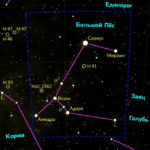
Sirius, the most luminous star in the constellation Canis Major and the entire night sky, has an apparent magnitude of -1.47. It serves as the apex of the Winter Triangle, together with the prominent stars Betelgeuse and Procyon. Remarkably, Sirius outshines even the closest star to the Sun, Alpha Centauri, as well as supergiants like Canopus, Rigel, and Betelgeuse. With its precise celestial coordinates, Sirius is visible to the naked eye and can even be observed during daylight hours.
In 1844, Friedrich Bessel proposed that Sirius comprised of two stars. In 1862, a companion star named Sirius B was identified by Alvan Clarke (here referred to as Sirius B in common parlance). The visible star is commonly known as Sirius A. These two stars revolve around a shared center of mass approximately 20 astronomical units away from each other, with a rotation period of about 50 years. In 1915, astronomers at Mount Wilson Observatory determined that Sirius B was a white dwarf, making it the first white dwarf to ever be discovered. Interestingly, this suggests that Sirius B was much more massive than Sirius A in the past, as it had already departed from the main sequence during its evolution.
According to current research, the age of Sirius is approximately 230 million years (with estimates ranging from 200 to 300 million years). Initially, Sirius was composed of two blue-white stars belonging to spectral class B. One of these stars, Sirius B, had a mass equivalent to 5 solar masses, while the other star, Sirius A, had a mass equivalent to 2 solar masses. The more massive star, Sirius B, underwent the process of burning out and transformed into a red giant before shedding its outer layer and transitioning into its current state as a white dwarf. Currently, Sirius A has a mass approximately twice that of the Sun, while Sirius B has a mass slightly less than that of the Sun. (Source: astroson.com, date: 2017-04-22).

The most brilliant celestial object visible from Earth is Sirius, a star located in the constellation of Canis Major. It possesses a mass that is more than double that of the Sun and emits light that is over twenty times brighter by comparison. With the exception of the extreme northern latitudes, Sirius can be observed from any point on Earth without the need for specialized instruments. The distance between planet Earth, the solar system, and Sirius is no more than 8.6 light years, which is approximately equivalent to 9 trillion 460 billion kilometers. Only Alpha Centauri is closer in proximity. Sirius boasts a temperature of 9600 degrees (in contrast to the Sun’s temperature of nearly five thousand five hundred degrees).
Throughout history, Sirius has been linked to legends and religious cults, with some hoping for extraterrestrial beings and kindred spirits to emerge from its presence.
The moment of this star’s discovery
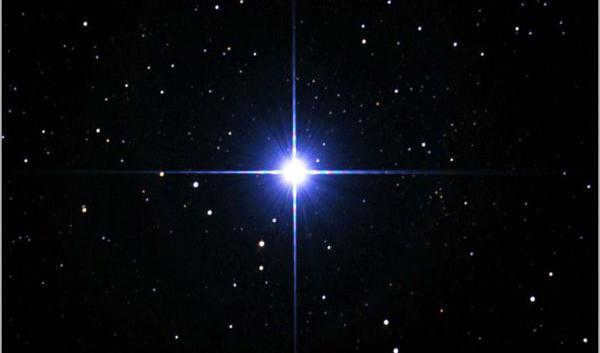
Sirius has been mentioned in various ancient civilizations, including the Sumerian and ancient Egyptian civilizations, as well as in Greek mythology and the Koran. Some African tribes, who have managed to preserve their authenticity from ancient times, still know about Sirius today, despite not being influenced by the civilized world.
During the Middle Ages, European and Arab astrologers attributed special magical significance to Sirius, along with fourteen other stars. The English, influenced by the erratic behavior of Charles the Second, believed that Sirius had a negative influence on people.
The question of whether Sirius is a star or a planet has never been a matter of debate. Its grand scale and magnificence make it clear that it is a star. Additionally, it is known that this celestial body has its own planetary system.
The title
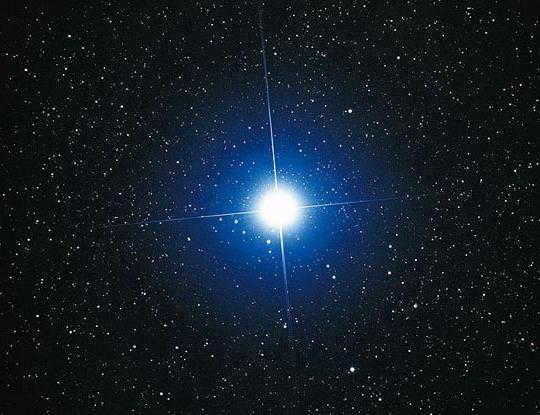
On the island of New Zealand, the people of Tuhoe referred to this celestial body as Antares. However, in modern times, it is commonly recognized as Sirius.
Planet Earth and Sirius: Locating the star in the nighttime sky
Sirius is most easily observed from Earth during the winter and spring seasons. In the autumn, it will only become visible in the late hours of the night.
To locate Sirius, begin by locating the constellation Orion and its distinctive three-star belt. Then, move approximately twenty degrees to the left of the belt (equivalent to the distance from your thumb to your little finger). There, you will immediately encounter a large, chilly luminous celestial object.
In 1844, evidence was presented demonstrating the existence of an imperceptible “companion” to the star Sirius. The nature of this object, whether it was a planet or not, remained unknown until nearly two decades later in 1862, when it was finally observed. This companion was revealed to be a second star, subsequently named Sirius B. The original star was then designated as Sirius A.
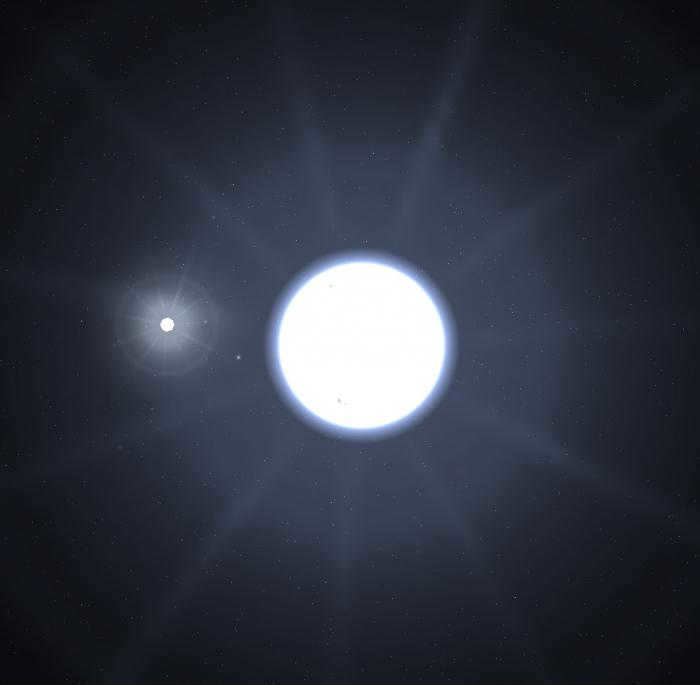
Scientists have conducted research to determine whether Sirius is a planet or a star. Their findings have revealed that Sirius is actually a white dwarf. Despite its small size, it has a similar mass to the Sun and is very dense. In fact, a teaspoon of matter on Sirius weighs about five tons due to its high density. The temperature on this ancient star is approximately twenty-five thousand degrees. Sirius B orbits around Sirius A, and the distance between the two can vary from eight to thirty astronomical units. With these facts in mind, there is no longer any doubt about whether Sirius is a star or a planet.
Most celestial bodies of this nature consist primarily of hydrogen, which, when subjected to high temperatures, undergoes a transformation into helium. This process can span billions of years. Once all of the hydrogen fuel has been depleted, the star transitions into a red giant as it begins to burn helium. Once this process reaches completion, the outer layers of the star detonate, giving rise to a planetary nebula with a white dwarf at its core. In this state, the star, while still emitting light, no longer generates energy and gradually cools, eventually transforming into a cold, lifeless remnant. Scientists estimate that Sirius B underwent this transformation into a white dwarf approximately 120 million years ago.
This massive star is presently in the process of depleting its hydrogen fuel. Afterward, it will also evolve into a red giant and subsequently transform into a white dwarf. The star is approximately 230 million years old and is currently moving towards the solar system at a velocity of 7.6 kilometers per second, meaning its luminosity will only intensify over time.
To which constellation does Sirius belong
Which constellation does Sirius pertain to? In the past, it was thought to be a part of the mobile group associated with the Big Dipper, which encompasses 220 celestial bodies that share the same age and similar patterns of movement. However, this cluster has since dissolved and is no longer gravitationally bound. Subsequently, researchers have determined that Sirius is significantly younger than the aforementioned group and thus does not belong to it.

There are also theories suggesting that Sirius, along with the star Beta Ascendant, Gemma, Beta Chalice, Cursa, and Beta Serpent, represents the alleged supergroup Sirius. This supergroup is one of three large clusters located within 500 light-years of the Sun. The other two clusters are known as the Pleiades and the Hyades.
It is now believed that Sirius is a star in the Big Dog constellation. It is the brightest celestial body in that constellation.
The constellation’s second most brilliant star is called Mirzam, which translates to “harbinger” because it emerges before Sirius ascends.
Another extraordinary celestial object is the eclipsing variable known as UW. These supergiants are extremely uncommon and have become ellipses due to their close proximity. They are currently the most massive stars ever discovered, surpassing the Sun’s mass by nearly thirty times and the Earth’s by 10 million times.
Procyon
Located near Sirius, at an elevation of 25 degrees, Procyon can be observed. This celestial body is the eighth most luminous in the night sky. Its designation originates from the Greek language, meaning “before the Dog,” as it ascends above the horizon in the Northern Hemisphere prior to Sirius. Procyon is a constituent of the Lesser Dog constellation.
Insights on Sirius from Earthlings
The ancient Egyptians constructed their pyramids in a manner that allowed starlight to shine upon their altars. The priests utilized this phenomenon to forecast the timing of the Nile’s annual flooding. The interval between heliacal risings was regarded by them as a complete calendar year.
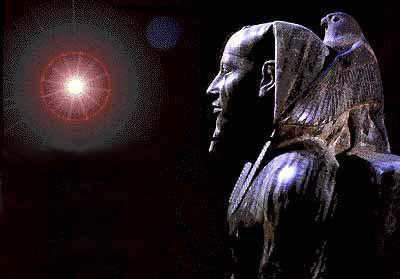
In Maori mythology, the divine entity known as Rehua is represented by Sirius, the brightest star in the sky. Rehua resides in the highest realm, the tenth heaven, and possesses the power to bring the dead back to life and heal any illness. The Maori people believed that by gazing upon Sirius, they were witnessing the presence of Rehua, the wisest being in the entire universe.
The Quran, the sacred text of the Islamic faith, which was revealed in the 7th century, contains references to the Sirius system that were only confirmed by scientists in the 19th century.
The Dogon tribe, native to Africa, had knowledge of the second star’s existence well before it was scientifically discovered. This tribe possesses a deep understanding of the Sirius system, believing it to consist of three celestial bodies. They are aware that Sirius has a rotation period of 50 years. Additionally, the Dogon people hold a grand celebration dedicated to the deities from the star Sirius. Despite their detachment from civilization and lack of modern amenities, they possess knowledge of the star’s size, mass, the structure of the solar system, and even the theory of the big bang.
One of the legends within the tribe tells the tale of Hommo, who arrived on Earth and brought two sets of twins, resulting in four individuals. Could it be that Homo sapiens were among them? And is it possible that these four twins became the ancestors of the future races of humanity?
“The Planet” Sirius and Earth – the connection. Esoterica
The Connection Between “The Planet” Sirius and Earth in Esoteric Studies
When examining esoteric studies, one cannot ignore the connection between the planet known as “The Planet” Sirius and Earth. This relationship holds great significance in the realm of esoterica.

There are numerous online articles claiming to be messages from the Sirians. According to these messages, the Sirians claim to be the protectors of our planet and, although they do not interfere in the progress of humanity, they still have a deep concern for it.
There are those who offer guidance to prevent harm towards one another and the Earth, while others share insights about the state of affairs in their own homeland. Some claim that they are not deities for humanity, but merely wish to assist us in becoming active participants in the cosmic community, a status that currently eludes mankind due to the abundance of negative energy permeating both the planet and its inhabitants. Certain individuals caution that not all beings are well-intentioned, and caution must be exercised, as some may masquerade as spiritual instructors or ascended masters, communicating through channeling to further their own undisclosed objectives.
This is how the connection between Sirius and Earth is said to occur in esoteric circles. It is believed that this connection can be established directly.
It is important to keep in mind that not all ancient civilizations view the extraterrestrial beings from this particular constellation as divine and enlightened entities. The course of history can be altered multiple times to cater to the agendas of those in positions of authority. As a result, there is a possibility that certain artifacts could have been fabricated or manipulated.
